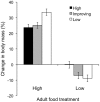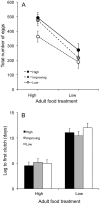The effects of larval nutrition on reproductive performance in a food-limited adult environment
- PMID: 21479211
- PMCID: PMC3068141
- DOI: 10.1371/journal.pone.0017399
The effects of larval nutrition on reproductive performance in a food-limited adult environment
Abstract
It is often assumed that larval food stress reduces lifetime fitness regardless of the conditions subsequently faced by adults. However, according to the environment-matching hypothesis, a plastic developmental response to poor nutrition results in an adult phenotype that is better adapted to restricted food conditions than one having developed in high food conditions. Such a strategy might evolve when current conditions are a reliable predictor of future conditions. To test this hypothesis, we assessed the effects of larval food conditions (low, improving and high food) on reproductive fitness in both low and high food adults environments. Contrary to this hypothesis, we found no evidence that food restriction in larval ladybird beetles produced adults that were better suited to continuing food stress. In fact, reproductive rate was invariably lower in females that were reared at low food, regardless of whether adults were well fed or food stressed. Juveniles that encountered improving conditions during the larval stage compensated for delayed growth by accelerating subsequent growth, and thus showed no evidence of a reduced reproductive rate. However, these same individuals lost more mass during the period of starvation in adults, which indicates that accelerated growth results in an increased risk of starvation during subsequent periods of food stress.
Conflict of interest statement
Figures



Similar articles
-
Larval nutrition-induced plasticity affects reproduction and gene expression of the ladybeetle, Cryptolaemus montrouzieri.BMC Evol Biol. 2015 Dec 8;15:276. doi: 10.1186/s12862-015-0549-0. BMC Evol Biol. 2015. PMID: 26643316 Free PMC article.
-
Fitness costs of reflex bleeding in the ladybird beetle Harmonia axyridis: the role of parental effects.Insect Sci. 2020 Dec;27(6):1346-1359. doi: 10.1111/1744-7917.12737. Epub 2019 Dec 12. Insect Sci. 2020. PMID: 31762189
-
Effects of resource variation during early life and adult social environment on contest outcomes in burying beetles: a context-dependent silver spoon strategy?Proc Biol Sci. 2014 Apr 30;281(1785):20133102. doi: 10.1098/rspb.2013.3102. Print 2014 Jun 22. Proc Biol Sci. 2014. PMID: 24789890 Free PMC article.
-
Do more food choices lead to bad decisions? A case study in predaceous ladybird beetle, Propylea dissecta.Bull Entomol Res. 2024 Dec;114(6):744-755. doi: 10.1017/S0007485324000555. Epub 2024 Dec 2. Bull Entomol Res. 2024. PMID: 39618200
-
Endocrine Control of Exaggerated Trait Growth in Rhinoceros Beetles.Integr Comp Biol. 2016 Aug;56(2):247-59. doi: 10.1093/icb/icw042. Epub 2016 Jun 1. Integr Comp Biol. 2016. PMID: 27252223 Review.
Cited by
-
You are what you eat: diet shapes body composition, personality and behavioural stability.BMC Evol Biol. 2017 Jan 10;17(1):8. doi: 10.1186/s12862-016-0852-4. BMC Evol Biol. 2017. PMID: 28073352 Free PMC article.
-
Adaptation to divergent larval diets in the medfly, Ceratitis capitata.Evolution. 2017 Feb;71(2):289-303. doi: 10.1111/evo.13113. Epub 2016 Nov 24. Evolution. 2017. PMID: 27883361 Free PMC article.
-
Direct and trans-generational responses to food deprivation during development in the Glanville fritillary butterfly.Oecologia. 2013 Jan;171(1):93-104. doi: 10.1007/s00442-012-2412-y. Epub 2012 Jul 20. Oecologia. 2013. PMID: 22814878
-
Effects of spawning Pacific salmon on terrestrial invertebrates: Insects near spawning habitat are isotopically enriched with nitrogen-15 but display no differences in body size.Ecol Evol. 2021 Aug 24;11(18):12728-12738. doi: 10.1002/ece3.8017. eCollection 2021 Sep. Ecol Evol. 2021. PMID: 34594534 Free PMC article.
-
The oxidative cost of reproduction depends on early development oxidative stress and sex in a bird species.Proc Biol Sci. 2016 Jun 29;283(1833):20160842. doi: 10.1098/rspb.2016.0842. Proc Biol Sci. 2016. PMID: 27358368 Free PMC article.
References
-
- Day T, Rowe L. Developmental thresholds and the evolution of reaction norms for age and size at life-history transitions. Am Nat. 2002;159:338–350. - PubMed
-
- Rowe L, Ludwig D. Size and timing of metamorphosis in complex life cycles: Time constraints and variation. Ecology. 1991;72:413–427.
-
- Honek A. Instraspecific variation in body size and fecundity in insects: a general relationship. Oikos. 1993;66:483–492.
-
- Andersson M. Princeton: Princeton University Press.; 1994. Sexual Selection.624
-
- Abrams PA, Rowe L. The effects of predation on the age and size of maturity of prey. Evolution. 1996;50:1052–1061. - PubMed
Publication types
MeSH terms
LinkOut - more resources
Full Text Sources
Medical

